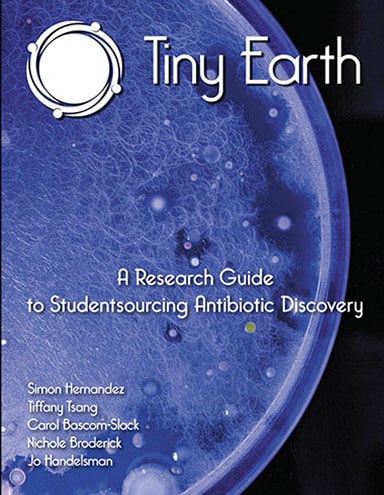Tiny Earth - A Research Guide to Studentsourcing Antibiotic Discovery (print book plus full FlexEd Digital Course Access)
by Jo Handelsman, et. al.
Revised Edition, 2022
Print book, plus full FlexEd Digital Course Access
Print Version
Paperback Price: $21.92
ISBN: 978-1-71147-072-6
208 pages
Purchase
For Print Copies:
Students - buy now on Amazon with the above 'Purchase' link

Also - ask your campus bookstore to order your copies directly from XanEdu:
Bookstores - send your PO to textbookorders@xanedu.com
(2022 Edition with FlexEd, ISBN 9781711470726)
Availability: In Stock/Ready to Ship
Suggested retail price approx. $21.92
For discounted Bookstore or School District bulk orders: Contact Us
About the Book
Tiny Earth is a network of instructors and students focused on crowd-sourcing antibiotic discovery from soil.
The challenges are huge...
Today we are fighting a shortage of effective antibiotics as "superbugs" evolve resistance to our most-used antibiotics. Simultaneously, we face a shortage of science trainees as unengaging introductory science courses fail to retain some of the best and brightest students in STEM fields.
But the solutions start tiny.
Unearthing new antibiotic-producing microbes from the soil can address a worldwide health threat while inspiring students to pursue careers in science. Tiny Earth brings the potential for global impact through original laboratory and field research conducted in introductory courses.
Tiny Earth is a network of instructors and students focused on crowdsourcing antibiotic discovery from soil. The mission of the program is two-fold:
First, it seeks to inspire students to pursue careers in science through original laboratory and field research conducted in introductory courses with the potential for global impact.
Second, it aims to address a worldwide health threat—the diminishing supply of effective antibiotics—by tapping into the collective power of many student researchers concurrently tackling the same challenge, living up to its motto "studentsourcing antibiotic discovery."
Read More about Tiny Earth
About the Author
Tiny Earth as we know it was launched in June of 2018, but it truly began six years earlier when Jo Handelsman founded a course—then called "Microbes to Molecules"—at Yale University with the goal of addressing both the antibiotic crisis and the shortage of science trainees. In short order, the course grew and became a part of a larger initiative until Handelsman returned to the University of Wisconsin-Madison and launched Tiny Earth in collaboration with its hundreds of partners worldwide.
Table of Contents
- Introduction
- How to Use This Research Guide
- Lab Safety and Best Practices
- General Lab Safety and Etiquette
- American Society for Microbiology Guidelines for Biosafety
- Tiny Earth Nonnegotiable Safety Rules
- Aseptic Technique
- Recordkeeping
- Labeling
- Section 1: Living on a Bacterial Planet
- Experiment 1: Devise a method to transfer microbes from a soil sample to a medium in the lab.
- Section 2: More Than Just “Dirt”
- Experiment 2: Find a local soil environment you wish to sample
- Section 3: Redefining “Growth” and “Culture”
- Experiment 3: Find a method to isolate single colonies of bacteria from your soil sample.
- Section 4: Bacteria Are What They Eat, Too
- Experiment 4: Choose your own media and culture conditions.
- Section 5: Solid Versus Liquid Cultures
- Experiment 5: Isolate unique colonies to test for antibiotic production.
- Section 6: Meet the ESKAPE Pathogens
- Experiment 6: Understand the significance of the ESKAPE pathogens and using safe relatives in the lab.
- Section 7: Antibiotics’ Discovery, Structure & Targets
- Experiment 7: Design a method to screen for antibiotic producers
- Section 8: Getting to Know Your Isolates
- Experiment 8: Initial identification of antibiotic-producing isolate
- Section 9: It All Comes Down to Chemistry
- Experiment 9: Testing isolate’s organic extract for antibiotic activity
- Section 10: Resisting Antibiotics
- Experiment 10: Testing isolate's resistance to common antibiotics
- Section 11: “Classic” versus “Modern”
- Experiment 11: Biochemical characterization of isolates
- Section 12: Bacteria in Context
- Experiment 12: Assess activity against eukaryotes, potential use as biological control, and ecological relationships with other organisms
- Concluding Remarks
- Part II: Research Protocols
